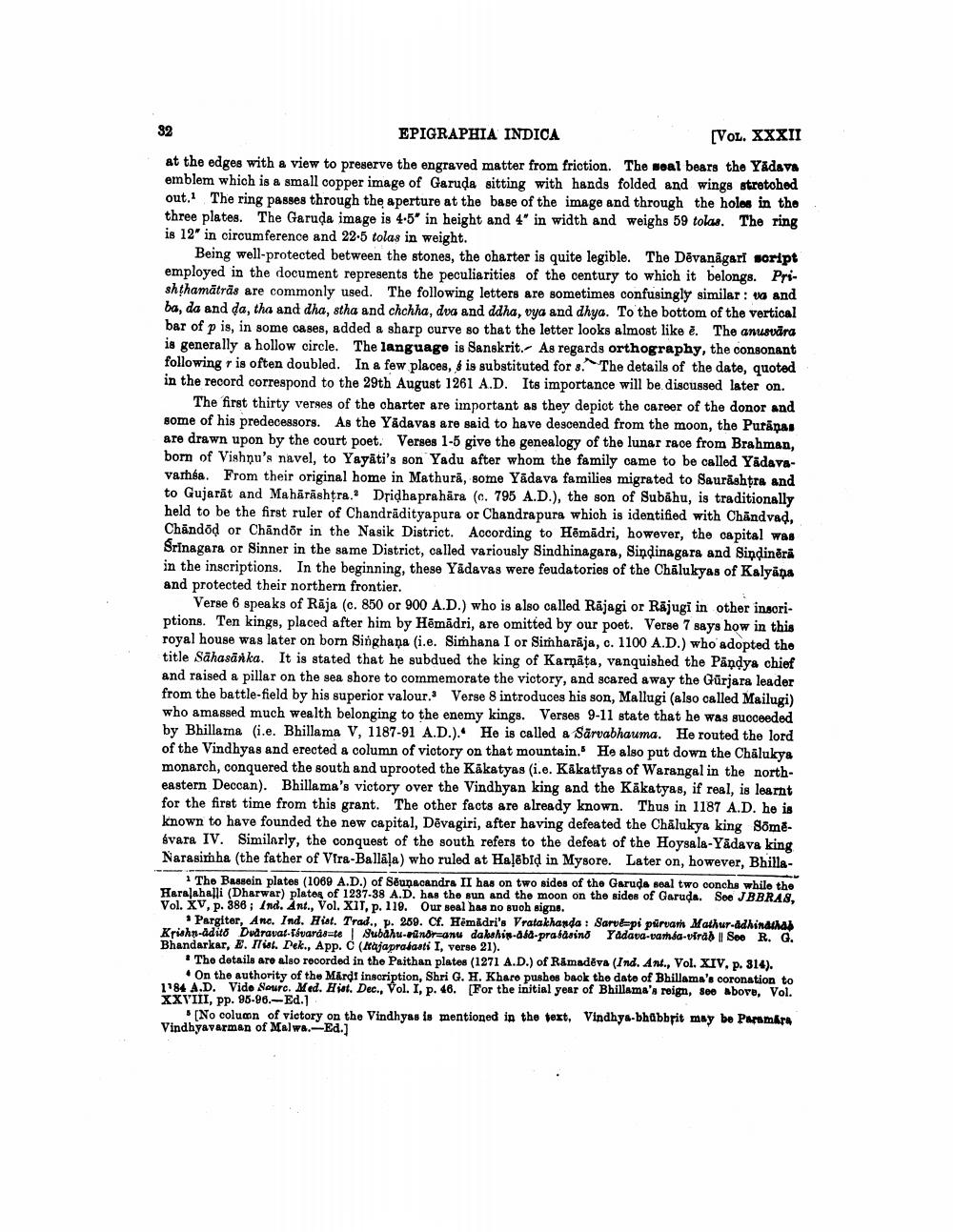________________
EPIGRAPHIA INDICA
[VOL. XXXII
at the edges with a view to preserve the engraved matter from friction. The soal bears the Yadava emblem which is a small copper image of Garuda sitting with hands folded and wings stretched out. The ring passes through the aperture at the base of the image and through the holes in the three plates. The Garuda image is 4-5' in height and 4" in width and weighs 59 tolas. The ring is 12" in circumference and 22.5 tolas in weight.
Being well-protected between the stones, the charter is quite legible. The Dēvanagari script employed in the document represents the peculiarities of the century to which it belongs. Prishthamātrās are commonly used. The following letters are sometimes confusingly similar: 1 and ba, da and da, tha and dha, stha and chchha, dva and ddha, vya and dhya. To the bottom of the vertical bar of p is, in some cases, added a sharp curve so that the letter looks almost like ē. The anusvära is generally a hollow circle. The language is Sanskrit.- As regards orthography, the consonant following r is often doubled. In a few places, & is substituted for 3. The details of the date, quoted in the record correspond to the 29th August 1261 A.D. Its importance will be discussed later on.
The first thirty verses of the charter are important as they depict the career of the donor and some of his predecessors. As the Yadavas are said to have descended from the moon, the Putānas are drawn upon by the court poet. Verses 1-5 give the genealogy of the lunar race from Brahman, born of Vishnu's navel, to Yayāti's son Yadu after whom the family came to be called Yadavavamsa. From their original home in Mathurā, some Yadava families migrated to Saurashtra and to Gujarat and Maharashtra. Dridhaprahāra (c. 795 A.D.), the son of Subāhu, is traditionally held to be the first ruler of Chandrädityapura or Chandrapura which is identified with Chandvad, Chándod or Chandör in the Nasik District. According to Hēmādri, however, the capital was Srinagara or Sinner in the same District, called variously Sindhinagara, Sindinagara and Sindineri in the inscriptions. In the beginning, these Yadaves were feudatories of the Chālukyas of Kalyans and protected their northern frontier.
Verse 6 speaks of Rāja (c. 850 or 900 A.D.) who is also called Rajagi or Rājugi in other insoriptions. Ten kings, placed after him by Hēmādri, are omitted by our poet. Verse 7 says how in this royal house was later on born Singhaņa (i.e. Simhana I or Simharāja, c. 1100 A.D.) who adopted the title Sähasānka. It is stated that he subdued the king of Karnāta, vanquished the Pandya chief and raised a pillar on the sea shore to commemorate the victory, and scared away the Gurjara leader from the battle-field by his superior valour.: Verse 8 introduces his son, Mallugi (also called Mailugi) who amassed much wealth belonging to the enemy kings. Verses 9-11 state that he was succeeded by Bhillama (i.e. Bhillama V, 1187-91 A.D.).• He is called a Sārvabhauma. He routed the lord of the Vindhyas and erected a column of victory on that mountain. He also put down the Chalukya monarch, conquered the south and uprooted the Käkatyas (i.e. Kakatiyas of Warangal in the northeastern Deccan). Bhillama's victory over the Vindhyan king and the Käkatyas, if real, is learnt for the first time from this grant. The other facts are already known. Thus in 1187 A.D. he is known to have founded the new capital, Dévagiri, after having defeated the Chalukya king somesvara IV. Similarly, the conquest of the south refers to the defeat of the Hoysala-Yadava king Narasimha (the father of Vira-Ballāla) who ruled at Haļēbid in Mysore. Later on, however, Bhilla
1 The Bassein plates (1069 A.D.) of Supacandra II has on two sides of the Garuda soal two conchs while the Haralahalli (Dharwar) plates of 1237-38 A.D. has the sun and the moon on the sides of Garuda. Soe JBBRAS, Vol. XV, p. 386; Ind. Ant., Vol. XIT, p. 119. Our seal has no such signe.
* Pergiter, Anc. Ind. Hist. Trad., p. 259. Cf. Hemidri's Vratakhanda : Sarut pi piruar Mathur-adhindihal Krishn-adito Dvdravat-Távaraste Subaru-vindranu dakshin-ada-prafasino Yadava-varda-vira) See R. G. Bhandarkar, E. Ii. D'ek., App. C (Majaprodaati I, verse 21).
* The details are also recorded in the Paithan plates (1271 A.D.) of Rimadēva (Ind. Ant., Vol. XIV. p. 314).
On the authority of the Márdi inscription, Shri G. H. Khare pushes back the date of Bhillama's coronation to 1984 A.D. Vide Sourc. Med. Hj. Dec., Vol. I, p. 46. For the initial year of Bhillama's reign, see above, Vol. XXVIII, PP. 95-96.-Ed.1
. (No column of victory on the Vindhyas is mentioned in the text, Vindhya-bhabbrit may be Paramkra Vindhyavarman of Malwa.-Ed.]




